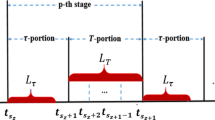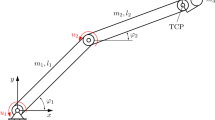Abstract
The purpose of this paper is to present the solution of time-optimal problem ofthe controlled object the dynamics of which is given by: \(\dot x = y\),\(\dot y = f(x) + u\), where \(\left| u \right| \leqslant 1\) and motion resistance function \(f(x) = 0\) if\(x \leqslant 0\),f(x)=-A if x > 0 where \(0 \leqslant A < 1\). That model describes dynamicsof a very important class of industrial installations. As the time-optimalproblem will be understood a transfer of the initial state \(z_0 = (x_0 ,y_0 ) \in R^2 \) to the target state \(z_1 = (x_1 ,0),x_1 \geqslant 0\) in a minimumtime \(t* < \infty \). There has been shown that in the formula defining resistancefunction f(x)there exists a value \(A = A_b = 2 - \sqrt 2 \) that plays an essentialrole in time-optimal structure formation. Namely, if \(A \leqslant A_b \) then thetime-optimal control process is typical, analogous as in classical case\(\ddot x = u,\left| u \right| \leqslant 1\), i.e. there exists a switching curve formed by thetrajectories of time-optimal solutions reaching the target state and thetime-optimal process is formed by at most one switching operation. For the caseA>Abwe will examine two following singular phenomena.
(a) If the target state z1=(0, 0) then there exists theswitching curve, dividing the state plane into two sets, however only one itsbranch is formed by the time-optimal solution reaching the target z1=(0, 0) and generated by the control u=-1. None of solution formsthe second branch of switching curve. It is formed by a state-locus dependingon the value of Aonly. In dependency of the starting state z0 thetime-optimal control process is generated by bang-bang control with none,one or two switching operations. This is the first singular phenomenon,because any small decrease of the value Aover A b requires to change thestructure which would be able to generate the time-optimal process.
(b) The paper shows, that if the target state z 1(x_1, 0), x1>0then there exists a set of the starting states from which there start twotrajectories reaching the target in the same minimum time. This is thesecond phenomenon.
Finally, some suggestions as to practical applications have been given too.
Similar content being viewed by others
References
Binding, P. (1979), Differential equations x = f ∘ x J. Diff. Equations 31, 183–189.
Brunovsky, P. (1974), The closed-loop time-optimal control. SIAM J. Control 12, 624–634.
Filippov, A.F. (1964), Differential equations with discontinuous right-hand side. Trans. Amer. Math. Soc. Ser. 2 42, 199–231.
Hajek, O. (1979), Discontinues differential equations. J. Diff. Equations 32, 149–185.
Hejmo, W. and Kloch J. (1984), On the time-optimal problem of positional control with discontinuous resistance of motion. RAIRO-System Analysis and Control 18, 329–341.
Hejmo, W. and Kloch J. (1989a), On the perturbations in a time-optimal closed-loop system. Annales Polonici Mathematici 50, 37–52.
Hejmo, W. and Kloch J. (1989b), Switching Curve Deformation in a Time-Optimal Closed-Loop System. IEEE. Tr. on Ac. 34, 654–656.
Sussman, H.J. (1980), The structure of time-optimal trajectories for single-input systems in the plane: C non-singular case. J. Diff. Equations 25, 433–465.
Utkin, V.I. (1971), Equations of Slipping Regime in Discontinuous Systems, I, II, Automation and Remote Control 32, 1897–1907, and (1972) 32, 211–219.
Young, D.S. (1977), Time-optimal feedback control. J. Optimal Theory Applications 21, 71–82.
Author information
Authors and Affiliations
Rights and permissions
About this article
Cite this article
HEJMO, W., KLOCH, J. On Singular Phenomena in Certain Time-Optimal Problem. Journal of Global Optimization 10, 327–349 (1997). https://doi.org/10.1023/A:1008211809388
Issue Date:
DOI: https://doi.org/10.1023/A:1008211809388




